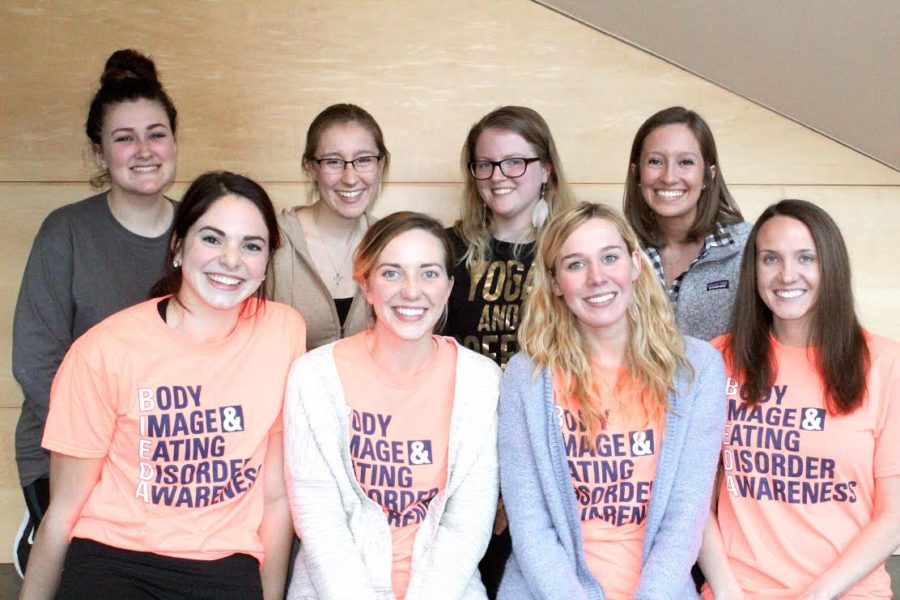Student uses personal experience to bring light to eating disorders
February 23, 2016
Rachel Dalton can recite the National Association of Anorexia Nervosa and Associated Disorders statistics by memory.
Eating disorders have the highest mortality rate among all mental illnesses, and 50 percent of people who suffer from anorexia develop bulimia or bulimic tendencies.
“Body image has always been something that’s been pretty negative to me,” said Rachel, junior in dietetics and co-president of Iowa State’s Body Image and Eating Disorder Awareness organization.
In the second grade, Rachel’s peers began referring to her as “overweight” or “fat.” It wasn’t long until the sixth grade that anorexia began to manifest.
Restricting calories and becoming interested in nutrition were some of the first signs that an eating disorder had worked its way into her life.
“I became really good at learning how I could manipulate food and see an immediate result in weight loss,” Rachel said. “For me personally, I focused on getting rid of fat completely. I had a phobia of fat. I didn’t eat peanut butter for like two or three years.”
Eating disorders “arise from a variety of biological, psychological and social factors,” according to the National Eating Disorders Association.
For Rachel, one of those factors was the desire to be the perfect child, student and athlete.
It wasn’t until high school, when the stress that comes with playing varsity sports, taking all-honors courses and adjusting to a new school, that the anorexia developed into much more.
She met with a counselor during high school, which made her more accepting to food.
“I started turning to food as an outlet to relieve stress,” Rachel said.
Shortly after she started her freshman year of high school, Rachel was invited to a gathering at her friend’s house. It was one of the first times she had hung out with people from her new school in a large group setting.
“It was a very anxiety-ridden experience,” Rachel said. “I just kept eating and snacking even though I was grossly full.”
She knew the food was not enough of an outlet.
“I had tried a lot of times when I was younger to purge, but it never worked,” she added. “Then I went up into my friend’s bathroom and let everything out and for some reason it worked that time.”
Binging and purging had opened up access to the foods that Rachel had been restricting from her diet for years.
“The funny thing is I turned to peanut butter a lot,” Rachel said. “It was always kind of a forbidden food.”
“Some people perceive bulimia as a way to cope with problems when they feel out of control,” according to the Walden Center for Education and Research.
During the nine to 10 months she had spent purging almost nightly, Rachel gained a new sense of control. She considered purging, along with working out, as compensatory actions that would allow her to control the negative effects of the binging.
“Eating disorders look different on everyone,” Rachel said. “They tend to hide themselves. My parents didn’t even know.”
It wasn’t until they received a call that their daughter had passed out at a friend’s house when Evelyn and Don Dalton became informed what their daughter was going through.
“We got a phone call that Rachel had passed out,” Evelyn said. “She was so dehydrated that she passed out and she chipped her tooth. They had to splint her wrist. We rushed her to the hospital.”
Don was confused about the events that had occurred.
“She’s the perfect daughter,” Don said. “But anytime she has a problem, she tends to internalize it because she just doesn’t want to bother us or get us concerned.”
Both Don and Evelyn said they are grateful Rachel opened up to them and allowed them to help her after the accident.
“As a mom, I felt so sad that my little girl was struggling so much,” Evelyn said. “It was hard. It was so hard.”
Rachel stressed how important it is for someone who is struggling with any eating disorders or body image issues to seek help or reach out to someone.
“I think that a lot of people don’t go and get help because they don’t think that they qualify to have an actual eating disorder,” said Chloé Lundquist, senior in dietetics and co-president of BIEDA. “More people die from that then people who are actually diagnosed with an eating disorder.”
Catching and treating eating disorders early can mean the difference between life and death.
“The earlier you seek treatment the better,” Rachel said. “You try to catch cancer early so that its ‘lethal-ness’ is brought down, but replace that with eating disorders. It’s the same thing.”
After years of counseling and opening up to loved ones about what she was going through, Rachel finally began distancing herself from the illness.
“A big part of it is relating to others,” Rachel said. “My relationship with food now is what I consider normal. There are some days where a little bit of self-doubt creeps in, but no matter how big those voices get, I know I nourish my body the way I should. I’m not going to restrict myself.”
She doesn’t hold back from confessing her favorite food.
“Peanut butter and I are best friends now,” Rachel added.
However, recovering from an eating disorder and body image issues has proven to be a life-long process.
“I was going through mine for seven years on and off, and every day is a bit of a recovery process,” Rachel said. “It does get harder the longer you wait for help.”
It does get harder but recovery is possible.
“A lot of people struggle with what is the definition of recovery,” Rachel said. “I know that for me it’s more of a day-by-day, situation-by-situation thing. Sure, the episodes are far, few and in-between but I still get them. Confronting triggers is always going to be something that’s new, and you might not encounter them every day.”
National Eating Disorders Awareness Week kicked off Monday, and the members of BIEDA along with its affiliate, the Eating Disorder Coalition of Iowa, have a series of events planned throughout the week to inform and promote self-awareness about the subjects of eating disorders and body image issues.
The first event of the week was a showing of the documentary “The Illusionists – a film about the globalization of beauty” on Monday evening in Carver Hall.
A discussion panel of experts on eating disorders and nutrition followed the showing of the documentary.
Other events planned include a baked goods giveaway, headline speakers Tom and Doris Smeltzer, authors of “Andrea’s voice-silenced by Bulimia,” The Emily Program: Athletes and Eating Disorders with guest speaker Lisa Diers, R.D, L.D., and of course the highly anticipated Rock Your Body event that will take place in the Memorial Union instead of the old State Gym like in previous years.
“We have so much stuff going on,” Lundquist said. “Every day of the week we have some kind of activity planned. It will be a fun and informative week.”
Throughout the school year, BIEDA hosts other events to promote awareness. Last fall, it hosted its second annual 5K at Ada Hayden Park, which featured a costume contest.
Along with the 5K in the fall, BIEDA also does what it calls “reverse” trick-or-treating, where members hand out candy with positive messages on it.
For this year’s National Eating Disorder Week, BIEDA is focusing on how eating disorders affect not only the person struggling but also the families and loved ones and how early intervention is critical.






